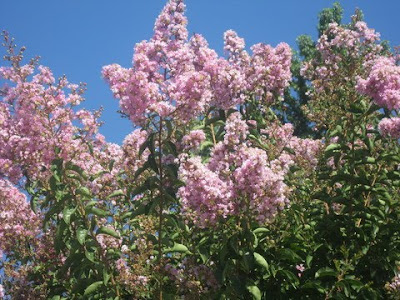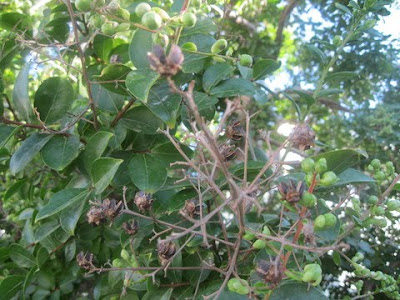Crape Myrtles are blooming all around us, so what better time to discuss how to take care of them? Crape Myrtles can be planted pretty much most of the year here in Southern California however this time of the year is ideal for selecting your tree or shrub. Wholesale nurseries, that usually only sell to landscapers, have great prices however they often have a smaller selection of varieties to chose from. Have your landscaper investigate retail and specialty nurseries (which will often extend a discount to them) because these venues often have a much larger selection of new cultivars. These trees and shrubs may be of a more appropriate size, color, or shape to be the perfect foil for your landscape design. You may be spending a little bit more, but in my opinion it will be worth every penny if this is a focal point, or accent for your garden. I’m not saying not to use one of the many beautiful older varieties EVER, just not as a statement or for a small area.
Crape Myrtle’s come in standard tree form, and in bush variety so take some time deciding which would work best for you in the situation you would like to use it in. They also come in a variety of sizes, make sure you take that into account as well. Remember, to pick all your plants for your space based on it’s MATURE size and your success rate with everything will go up a notch. The saying SIZE MATTERS is a true one when it comes to plants. They are also deciduous (lose their leaves in the fall) and often have beautiful fall color so take that into account when giving consideration to placement (perhaps not the best for a poolside). They also have beautiful peeling bark which adds to their year round interest. Now that you have selected and purchased your Crape Myrtle it’s time to learn a little bit about what they need and how to care for them.
Crape Myrtles are a full sun plant, they can be drought tolerant (moderate water in Sunset Garden Book) however they thrive and bloom better with supplemental water. They don’t need much pruning, and respond well to both fertilization and mulching. Let’s investigate further:
To plant your new baby, dig a hole about twice as wide as the root ball of your plant and as deep as the can that it comes out of, no deeper! If you plant the tree a little high, (the plant not you) it is much better than burying the trunk too low in the ground. A measuring device is always a nice tool to use (you can just measure using your shovel) so that you don’t have to pull the tree in and out of the hole.
Pruning is not essential for a Crape Myrtle, however it is a great tool to shape your plant. Start out by removing cross branches, dead wood, and small spindly shoots. Then prune to shape and pretty much leave the plant alone after that. Since they bloom on this year’s growth you can deadhead spent blossoms to encourage another set of blooms. It is best not to prune too late in the season as this promotes growth at the wrong time of the year and the tender new shoots could easily be damaged by the cold. Remember if you pick the right cultivar based on it’s size and the space that you have, little pruning will be required. If you buy a plant that is going to be 20’ wide and you only have 10’ you’ll forever have problems (this goes with ANY type of plant).
Water, as with all new transplants your Crape Myrtle needs to be watered regularly while it becomes established. And as with most trees it is better to give infrequent deep watering than frequent shallow watering. So, if you have a slope or clay situation you should cycle your irrigation. A few minutes on, let the soil accept the water for an hour or so, then a few more minutes of water and repeat this process. At this time of the year (July) in this heat it is best to have your irrigation running from about 2 am through 6 am. You will save water and give your plants a fighting chance against the hot summer sun.
Mulch, I can’t ever say enough about mulch. Mulch helps retain water, holds back weeds, provides a nice barrier from yard equipment, and when you are using organic matter (which for all but desert plants is my favorite choice) it “gives back” to the soil. 2”-3” of organic material is just what the tree doctor ordered!
Fertilizing, I like a granular organic fertilizer to help give the Crape Myrtle a boost it does a lot of blooming so it needs some extra food. Balanced fertilizer is okay, but I personally like something with a little extra the middle number on the fertilizer package is phosphorus, which promotes flowers (because it builds strong roots and fruits) so if I have the option I like to have a slightly higher middle number for plants that flower a lot. If you have dogs, beware of organic fertilizer… it smells like lunch and they might just be out there digging. More about that at another time.
Problems – powdery mildew can be a problem for Crape Myrtles however if you plant your tree in the sun and allow plenty of room for air circulation around it (again… size and spacing really matter) your plant should do well. (You can also read up about cultivars that are resistant to specific problems). Sooty mold is another problem that is common in Crape Myrtles it is caused by aphids, which secrete a sticky substance that the mold is attracted to. It can become quite thick and end up damaging the plant because it can’t photosynthesize. The best way to prevent this is by controlling the aphids before they get out of hand. You can spray the aphids with a strong jet of water from your hose, and/or use beneficial insects like ladybugs or lacewings. If you don’t notice the problem until it the sooty mold has accumulated, you can wash you Crape Myrtle with a mixture of dish soap and water and then hose it off.
If you are reading this and live in the northern most parts of the Crape Myrtle’s zones you should take a few precautions prior to the cold setting in. Water the tree well before the ground freezes and make sure that it has at about 4” of mulch. Even with these precautions, you may find that the tops of your trees may die, just plan to prune in early spring and know that if you plant dies way back you will certainly end up with a plant that looks much more like the shrub shape than a standard tree.
Crape Myrtles are beautiful additions to most Gardens, and as you can see are relatively easy to take care of, so… if you want a nice bright pop of color this is a great plant for you.
For more about my designs: thegrassisalwaysgreener














